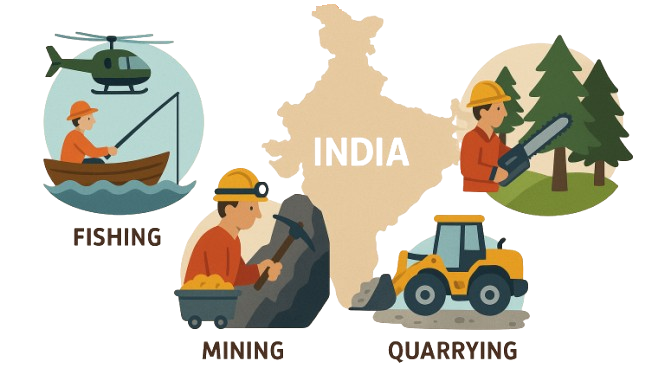| Smash 2025 FLT 11 Q5. Evaluate the impact of PM Matsya Sampada Yojana in transforming India’s fisheries sector. What more needs to be done to ensure sustainability and inclusiveness? Smash 2025 Adv Test 07 Q10. Despite being the largest milk producer, India faces a growing demand-supply gap in the dairy sector. Identify the reasons behind this gap and suggest strategies to bridge it. Smash 2025 Adv Test 07 Q20. Despite its economic significance, the livestock sector faces multiple challenges. Discuss. Also, suggest a comprehensive strategy to strengthen the sector. |
| PYQ Q. Define blue revolution, explain the problems and strategies for pisciculture development in India. (2018) |
Non-farm primary activities are economic activities of the primary sector that do not involve crop farming, but rely on direct exploitation of natural resources. These include animal rearing, fishing, forestry, mining, and quarrying
Key features of primary activities in point format (no elaboration, no examples):
- Direct dependence on nature
- First stage of production
- Labour-intensive
- Extensive land use
- Low value addition
- Seasonal dependence
- Geographically localised
- Rural dominance
- High employment share in developing economies
Relation to Physiographic Features
- Animal Rearing – Relief & climate decide type of livestock.
- Sheep and goat in Thar Desert;
- yak in Ladakh;
- camel in Rajasthan arid zone;
- dairy farming in Indo-Gangetic plains.
- Fishing – Coastal morphology, deltas, and rivers enable both marine and inland fishing.
- Marine fishing along Konkan & Malabar coasts;
- Prawn culture in Chilika Lake;
- Riverine fishing in Brahmaputra & Ganga basins.
- Forestry – Forest type depends on terrain and rainfall.
- Teak in Western Ghats;
- Chir pine in Himalayas;
- Lac in Chhota Nagpur Plateau;
- Bamboo in North-East India.
- Mining & Quarrying – Geological formations dictate mineral wealth.
- Coal in Damodar Valley;
- Iron ore in Odisha-Jharkhand belt;
- Petroleum in Assam & Mumbai High;
- Mica in Andhra Pradesh;
- Bauxite in Nilgiri hills.
- Horticulture & Plantation (resource-driven) – Relief and climate support fruits and plantations.
- Apple in Himachal & Kashmir valleys;
- Tea in Assam hills & Nilgiris;
- Coffee in Karnataka Western Ghats.
- Salt Production – Arid coastal plains and saline soils encourage salt-making. Eg– Rann of Kutch (Gujarat) is India’s largest salt producer.
- Pearl & Coral Collection – Shallow warm seas favor natural pearl and coral activities. Eg– Gulf of Mannar (Tamil Nadu) famous for pearl fisheries.
- Gathering and Hunting (traditional) – Tribal populations depend on forests for NTFPs Eg– Honey and gum collection in Madhya Pradesh forests; shifting cultivation tribes supplementing food in North-East hills.
Non-farm primary activities in India are strongly tied to physiographic zones, highlighting the direct interdependence of livelihoods on geography.
- Mountains & Highlands
- Animal Rearing – Yak in Ladakh, sheep in Kashmir Himalayas.
- Forestry – Chir pine in Himalayas, temperate fruit orchards (apple) in Himachal & Kashmir.
- Plantations – Tea in Darjeeling & Nilgiris, coffee in Western Ghats.
- Mining – Bauxite in Nilgiri Hills, mica in Jharkhand plateau uplands.
- Plateaus
- Mining & Quarrying – Coal in Damodar Valley, iron ore in Odisha–Jharkhand belt, manganese in Nagpur–Balaghat belt.
- Forestry & Gathering – Lac, tendu leaves, bamboo in Chhota Nagpur Plateau & Central India forests.
- Cattle Rearing – Dry plateau zones of Deccan support goat and cattle.
- Plains
- Dairy Farming – Large-scale milk production in Indo-Gangetic plains (Punjab, Haryana, UP).
- Fishing & Aquaculture – Inland fisheries in Ganga-Brahmaputra river system.
- Sericulture – Mulberry cultivation in Karnataka plains.
- Coastal Regions
- Marine Fishing – Tuna & mackerel along Malabar & Konkan coasts; prawn culture in Chilika Lake.
- Pearl & Coral Collection – Gulf of Mannar (Tamil Nadu).
- Salt Production – Rann of Kutch (Gujarat), Chennai coast.
- Plantations – Coconut in Kerala coast, cashew in Konkan & Goa.
- Oil & Gas – Offshore drilling in Mumbai High.
- Desert & Arid Regions
- Animal Rearing – Camel, goat, sheep in Thar Desert (Rajasthan).
- Salt Production – Evaporative pans in Rann of Kutch.
- Gypsum & Lignite Mining – Western Rajasthan.


